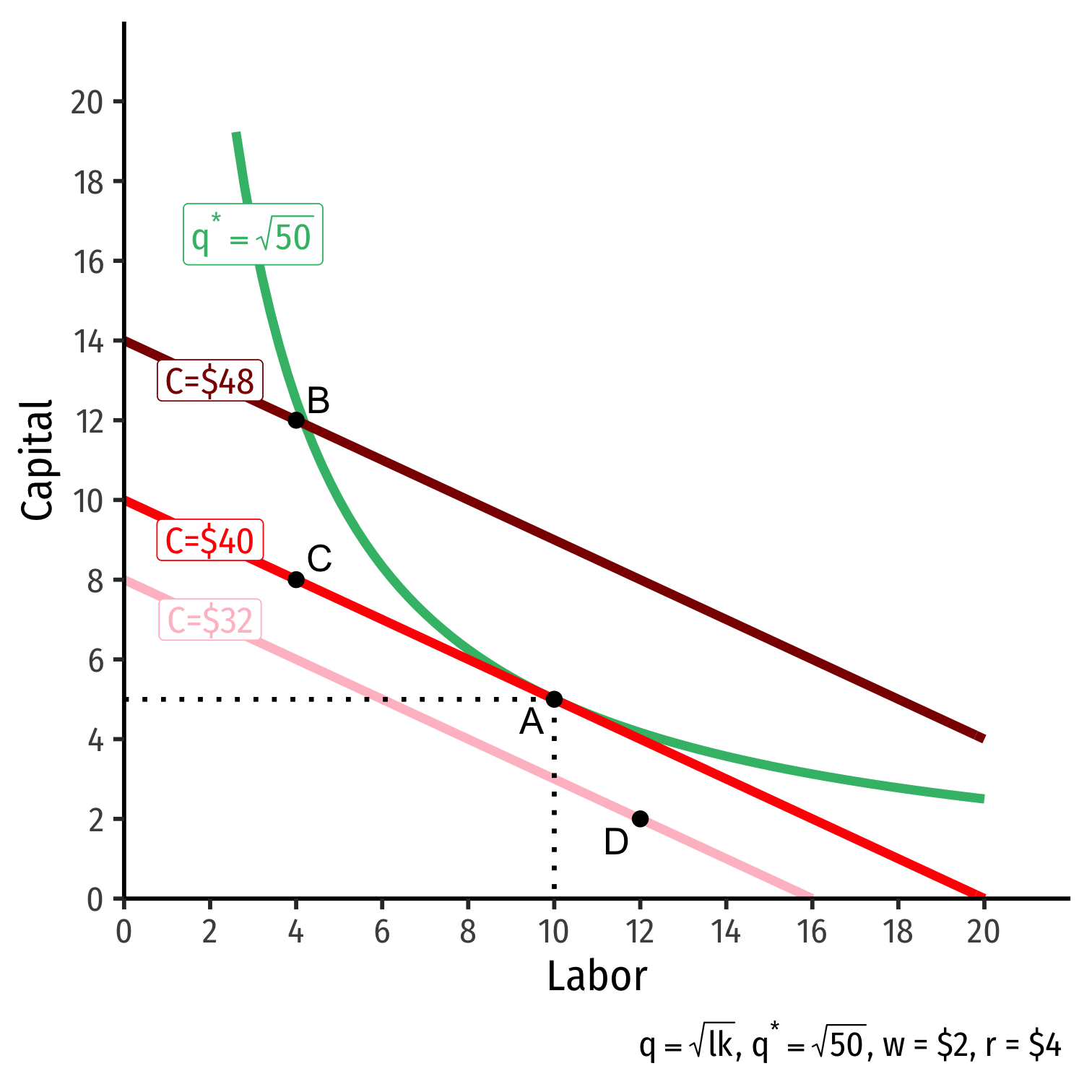2.3 — Cost Minimization
ECON 306 • Microeconomic Analysis • Spring 2022
Ryan Safner
Assistant Professor of Economics
safner@hood.edu
ryansafner/microS22
microS22.classes.ryansafner.com
Recall: The Firm's Two Problems
1st Stage: firm's profit maximization problem:
Choose: < output >
In order to maximize: < profits >
- We'll cover this later...first we'll explore:
2nd Stage: firm's cost minimization problem:
Choose: < inputs >
In order to minimize: < cost >
Subject to: < producing the optimal output >
- Minimizing costs ⟺ maximizing profits

Solving the Cost Minimization Problem
The Firm's Cost Minimization Problem
- The firm's cost minimization problem is:
Choose: < inputs: l,k>
In order to minimize: < total cost: wl+rk >
Subject to: < producing the optimal output: q∗=f(l,k) >

The Cost Minimization Problem: Tools
Our tools for firm's input choices:
Choice: combination of inputs (l,k)
Production function/isoquants: firm's technological constraints
- How the firm trades off between inputs
- Isocost line: firm's total cost (for given output and input prices)
- How the market trades off between inputs

The Cost Minimization Problem: Verbally
- The firms's cost minimization problem:
choose a combination of l and k to minimize total cost that produces the optimal amount of output

The Cost Minimization Problem: Math
min s.t. \quad q^*=f(l,k)
- This requires calculus to solve. We will look at graphs instead!

The Firm's Least-Cost Input Combination: Graphically
- Graphical solution: Lowest isocost line tangent to desired isoquant (A)

The Firm's Least-Cost Input Combination: Graphically
Graphical solution: Lowest isocost line tangent to desired isoquant (A)
B produces same output as A, but higher cost
C is same cost as A, but does not produce desired output
D is cheaper, does not produce desired output

The Firm's Least-Cost Input Combination: Why A?
\begin{align*} \color{green}{\text{Isoquant curve slope}} &= \color{red}{\text{Isocost line slope}} \\ \end{align*}

The Firm's Least-Cost Input Combination: Why A?
\begin{align*} \color{green}{\text{Isoquant curve slope}} &= \color{red}{\text{Isocost line slope}} \\ \color{green}{MRTS_{l,k}} &= \color{red}{\frac{w}{r}} \\ \color{green}{\frac{MP_l}{MP_k}} &= \color{red}{\frac{w}{r}} \\ \color{green}{0.5} &= \color{red}{0.5 } \\\end{align*}
Marginal benefit = Marginal cost
- Firm would exchange at same rate as market
No other combination of (l,k) exists at current prices & output that could produce q^\star at lower cost!

Two Equivalent Rules
Rule 1
\frac{MP_l}{MP_k} = \frac{w}{r}
- Easier for calculation (slopes)

Two Equivalent Rules
Rule 1
\frac{MP_l}{MP_k} = \frac{w}{r}
- Easier for calculation (slopes)
Rule 2
\frac{MP_l}{w} = \frac{MP_k}{r}
- Easier for intuition (next slide)

The Equimarginal Rule Again I
\frac{MP_l}{w} = \frac{MP_k}{r} = \cdots = \frac{MP_n}{p_n}
Equimarginal Rule: the cost of production is minimized where the marginal product per dollar spent is equalized across all n possible inputs
Firm will always choose an option that gives higher marginal product (e.g. if MP_l > MP_k)
- But each option has a different cost, so we weight each option by its price, hence \frac{MP_n}{p_n}
The Equimarginal Rule Again II
Any optimum in economics: no better alternatives exist under current constraints
No possible change in your inputs to produce q^* that would lower cost

The Firm's Least-Cost Input Combination: Example
Example:
Your firm can use labor l and capital k to produce output according to the production function: q=2lk
The marginal products are:
\begin{align*} MP_l&=2k\\ MP_k&=2l\\\end{align*}
You want to produce 100 units, the price of labor is $10, and the price of capital is $5.
- What is the least-cost combination of labor and capital that produces 100 units of output?
- How much does this combination cost?
Returns to Scale
Returns to Scale
- The returns to scale of production: change in output when all inputs are increased at the same rate (scale)

Returns to Scale
The returns to scale of production: change in output when all inputs are increased at the same rate (scale)
Constant returns to scale: output increases at same proportionate rate to inputs change
- e.g. double all inputs, output doubles

Returns to Scale
The returns to scale of production: change in output when all inputs are increased at the same rate (scale)
Constant returns to scale: output increases at same proportionate rate to inputs change
- e.g. double all inputs, output doubles
Increasing returns to scale: output increases more than proportionately to inputs change
- e.g. double all inputs, output more than doubles

Returns to Scale
The returns to scale of production: change in output when all inputs are increased at the same rate (scale)
Constant returns to scale: output increases at same proportionate rate to inputs change
- e.g. double all inputs, output doubles
Increasing returns to scale: output increases more than proportionately to inputs change
- e.g. double all inputs, output more than doubles
Decreasing returns to scale: output increases less than proportionately to inputs change
- e.g. double all inputs, output less than doubles

Returns to Scale: Example
Example: Do the following production functions exhibit constant returns to scale, increasing returns to scale, or decreasing returns to scale?
q=4l+2k
q=2lk
q=2l^{0.3}k^{0.3}
Returns to Scale: Cobb-Douglas
One reason Cobb-Douglas functions are great: easy to determine returns to scale:
q=Ak^\alpha l^\beta\alpha + \beta = 1: constant returns to scale
- \alpha + \beta >1: increasing returns to scale
\alpha + \beta <1: decreasing returns to scale
Note this trick only works for Cobb-Douglas functions!

Cobb-Douglas: Constant Returns Case
A common case of Cobb-Douglas is often written as:
q=Ak^\alpha l^{1-\alpha} (i.e., the exponents sum to 1, constant returns)\alpha is the output elasticity of capital
- A 1% increase in k leads to an \alpha% increase in q
1-\alpha is the output elasticity of labor
- A 1% increase in l leads to a (1-\alpha)% increase in q

Output-Expansion Paths & Cost Curves

Goolsbee et. al (2011: 246)
Output Expansion Path: curve illustrating the changes in the optimal mix of inputs and the total cost to produce an increasing amount of output
Total Cost curve: curve showing the total cost of producing different amounts of output (next class)
See next class' notes page to see how we go from our least-cost combinations over a range of outputs to derive a total cost function